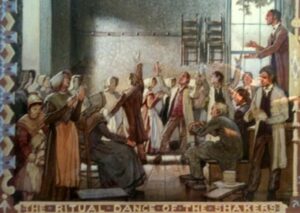
“I Will Be a Child of Peace” by Elaine Hagenberg offers an origins two-fer: the beginning of her career as a published choral composer/arranger and the source of the music itself. “Peace” was Hagenberg’s first published piece back in 2013. The piece has now been voiced for SATB, TTBB, and SSA. She must really like it!
The original song is a Shaker hymn:
“O Holy Father,” according to manuscripts, originated in 1851. [The manuscripts] attribute it to Alonzo Gilman of the community in Alfred, Maine. Sr. Mildred said that in her youth the song was used very frequently “at the close of prayer services while we were on our knees.” The song is in 5/4 time. (Notes on Songs in the Film, Shakers)
Here’s what Hagenberg herself has to say:
I was originally drawn to this song by the beautiful simplicity of the Shaker melody, unique 5/4 meter and, most importantly, the uplifting text of a prayer for peace and purity. (from the composer’s website) A followup e-mail from her says that she ran across it on iTunes: “That is the first place I heard it, and to my knowledge it has never been written down. I transcribed it, then added SATB and a piano accompaniment.”
The song shifts meters, going from 4/4 to 5/4 to 2/4 to 3/4. Posts on this site rarely if ever deal with any issues remotely connected with music theory or analysis, but the meter is singled out for commentary in both sources above and so is worthy of note. Did the original author, Mr. Gilman, not have a firm grasp of time signatures? Or did he write his hymn that way on purpose? I guess we’ll never know; some questions are lost to history. I like the image of Hagenberg listening intently to the digital track and thinking, “What on earth is that meter?” Also of note is the fact that she had to add the additional vocal harmonic lines; pre-Civil War Shaker hymns were always sung in unison, usually unaccompanied. They also did not use conventional notation. After the War they started writing songs in four-part harmony and publishing their music, so it became much more widely known. But many critics say that these conventionally-written tunes don’t have the striking originality of the earlier works.
When we get to the words we’re on firmer ground. The text is very brief:
O Holy Father I will be
a child of peace and purity
for well I know Thy hand will bless
the seeker after righteousness.
The belief system of the Shakers was pretty unconventional, based as it was on the leadership of a woman, Mother Ann Lee, in the mid-1700’s. After a great deal of persecution in England the sect emigrated to America in 1774 and formed their first colony. They believed in pacificism, egalitarianism, communal living, and, most dauntingly, strict celibacy. Take a look at this post if you’d like to read more about them. Taken on their own terms, the words to “Child” are squarely within those traditions. Devout Shakers believed they were living within Christ’s kingdom on earth. There was no call for worldly distractions, and they’d be blessed by following the rigid rules set for true believers. Given those beliefs, wouldn’t you think that they’d just sort of camp out and “take no thought for the morrow, what ye will eat, and what ye will drink, and what ye will put on,” as Jesus said to his disciples, expecting God to rain down blessing on them? But no. Shaker communities gained the rather grudging respect of their more-conventional neighbors by their hard work, cleanliness, and high standards. Their days were a mixture of hard manual labor and ecstatic worship and dancing. So fascinating! If ever I find myself in the area of a Shaker museum (of which there are a surprising number), I’ll definitely make a stop.
But a belief in Shaker theology isn’t necessary in order to appreciate the words and enjoy listening to or singing Hagenberg’s lovely arrangement, in whatever voicing we may be using. Peace, purity, righteousness and blessing are all positive goods, no matter the context.
Here’s a whole selection of videos from which you can pick and choose:
First, Hagenberg’s arrangement for treble voices:
Then for SATB — not the greatest video quality, and not many views — but what a supercool performance!
And then my fave (since that’s the version I’m getting to sing in my own choir’s concert) — TTBB:
A-a-a-a-nd, if you’ve gotten this far, here’s the 30-minute film about the Shakers that I referenced above:
(The film isn’t available directly on YouTube. If you’d like to hear some real live Shakers singing “Child of Peace,” go to the timestamp of 27:23. And if you’d like to get a clue about Mother Ann’s devotion to celibacy, start listening at about minute 8:00.)

